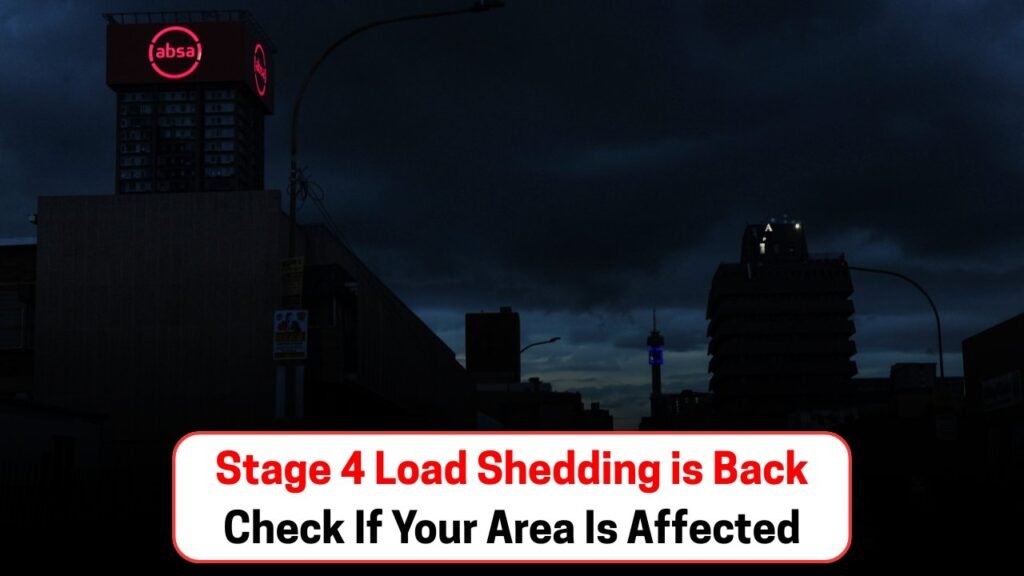Stage 4 Load Shedding Returns: As South Africa braces for another round of power interruptions, Eskom has announced the return of Stage 4 load shedding. This development is part of a broader strategy to manage the country’s electricity grid amid ongoing challenges. The announcement comes with a detailed, area-wise schedule for the month of August, offering residents a glimpse into the daily power outage plan. Load shedding remains a significant issue in South Africa, impacting both households and businesses. With the return of Stage 4, communities across the nation are preparing for longer periods without electricity, which may affect everything from daily routines to economic productivity. Eskom’s decision to implement this level of load shedding is driven by the need to balance supply and demand effectively and to prevent a total grid collapse.

Eskom’s August Schedule: Understanding the Area-Wise Breakdown
In response to the ongoing electricity crisis, Eskom has released an area-wise schedule for Stage 4 load shedding throughout August. This schedule is designed to provide South Africans with a clear understanding of when their areas will experience power cuts, allowing them to plan accordingly. The detailed breakdown is crucial for both residential and commercial sectors as it helps in minimizing disruption. Eskom’s approach involves rotating power cuts across different areas, which means that while one region experiences a blackout, others may still have electricity. This rotation is intended to ensure fairness and balance in power distribution during these challenging times. The schedule has been made available on Eskom’s official platforms, and residents are encouraged to stay informed by checking updates regularly. It’s important for businesses, in particular, to align their operations with the schedule to mitigate potential losses and maintain productivity.
The Impact of Stage 4 Load Shedding on South African Communities
The return of Stage 4 load shedding is expected to have profound effects on South African communities. For many households, this means adjusting daily routines to accommodate power outages, which can last several hours at a time. The impact extends beyond inconvenience, affecting the functionality of home appliances, internet connectivity, and even essential services like healthcare. In rural areas, where backup power solutions are less accessible, the repercussions can be even more severe. For businesses, especially those in manufacturing and service industries, the economic implications are significant. Reduced productivity during power cuts can lead to financial losses and may necessitate shifts in operational strategies. Small businesses, in particular, may struggle to cope with the unpredictability of power availability, highlighting the need for effective contingency planning. Overall, load shedding remains a formidable challenge that requires the collective effort of government, businesses, and citizens to navigate successfully.
Strategies for Coping with Load Shedding in August
As Stage 4 load shedding takes hold, South Africans are exploring various strategies to cope with the disruptions. One of the most effective approaches is investing in alternative energy sources, such as solar panels and generators, which provide a reliable backup during outages. For those unable to afford such solutions, smaller steps like using battery-powered devices and energy-efficient appliances can help. Community initiatives, where neighbors collaborate to share resources during power cuts, have also proven beneficial. It’s equally important for individuals to stay informed by keeping track of Eskom’s schedule and updates to anticipate outages. Businesses can explore flexible work arrangements, such as remote work, to maintain operations during load shedding. Additionally, investing in uninterruptible power supplies (UPS) can ensure that critical systems remain operational. By adopting these strategies, South Africans can mitigate the impact of load shedding and continue to thrive despite the challenges.
Government and Eskom’s Efforts to Address Load Shedding
In light of the persistent electricity challenges, both the government and Eskom are actively working on solutions to address load shedding. Eskom is focusing on maintenance and upgrades to its power plants to improve efficiency and reliability. The government, on the other hand, is exploring partnerships with independent power producers (IPPs) to diversify the energy supply chain. This includes the promotion of renewable energy projects that can provide sustainable power solutions. Additionally, there are ongoing discussions about regulatory reforms to encourage private sector involvement in the energy sector. These efforts are aimed at not only reducing the frequency and severity of load shedding but also ensuring a stable and reliable energy future for South Africa. While these initiatives represent a positive step forward, their success will depend on effective implementation and cooperation among all stakeholders. South Africans remain hopeful that these combined efforts will lead to a more resilient and dependable power system in the long run.



